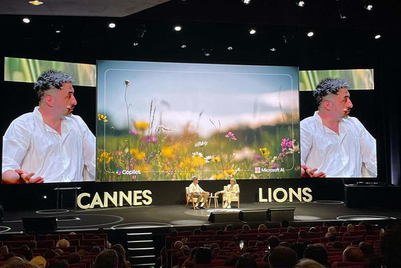
From Vodafone elves to Lego treasure hunts, Jeremy Stern, CEO, PromoVeritas delves into the growing trend of brands taking a leap into the phygital world to boost engagement and stand out from the crowd.
Whilst the media is full of stories about AI and how it will change all of our futures, let us not forget the technology of today that is already revolutionising how people interact with the digital world and their physical surroundings: Augmented Reality (AR). By integrating computer-generated enhancements into real-world environments, AR can create a real-time interaction between the two, forming a seamless blend between virtual and physical experiences.
This provides marketers with a whole new landscape to explore, utilising the endless possibilities that AR can create – whilst consumers are given the opportunity to experience a brand, or participate in a virtual activity, without having to fork over cash
Originally an expensive add-on, recent advancements have democratised the technology, providing brands of all sizes with a myriad of low-cost opportunities to engage with audiences in novel and compelling ways. You start at the low end, with ‘marker-based AR’, where a ‘marker’ (such as a QR code or bar code) can take the consumer to a customised AR experience, and can make your way up to projection AR, which overlays AR content over real world objects through the use of lights and projector mapping technology.
Unlocking the marketing benefits of AR technology
I particularly like to use AR in conjunction with prize promotions, where it can add to the fun and the effectiveness of a campaign tool. Recently, we worked with LEGO on a giant AR prize promotion for its Insiders Treasure Hunt; fans had the chance to virtually scan Lego bricks at home or instore to see if any of them were special, hidden ‘golden bricks’, making them eligible to win millions of prizes. It was a roaring success, which helped increase user engagement with LEGO’s tech-savvy younger audience.

This builds upon one of the key advantages of using AR in marketing: it’s an incredibly effective tool for reaching younger demographics – particularly the much sought-after Gen Z. Growing up in a digital age characterised by constant connection and technological innovation, younger consumers are inherently familiar and comfortable with AR.
In recent years the dramatic success of AR games such as Pokémon Go is proof of how effective the technology can be in grabbing the attention of younger generations. Brands can capitalise on this opportunity and embrace this technology in their marketing efforts by incorporating AR into their promotions, and thus differentiate themselves from the competition.
Engaging with the consumer
AR promotions also provide a better platform for consumers to engage with products in a meaningful way, ultimately improving the overall consumer experience. For example, Ikea has a tool that enables you to virtually place items of furniture into an image of your own living space so consumers can see how it fits and how the colours match. Over Christmas, Vodafone, via their agency Dentsu, also ran the ‘Elf and Seek’ game for a second successful year. This saw over 250,000 participants take to the streets to scan digital billboards in major cities in the hopes of capturing an AR hidden ‘Elf’ and winning a prize.
By providing interactive and informative content, combined with relevant prizes as an incentive, AR enhances the shopping experience and offers a level of interactivity and personalisation beyond traditional methods. As it creates memorable and engaging experiences it can actually foster emotional connections between brands and consumers, strengthening brand loyalty and affinity. It is this power to resonate with audiences on a deeper level that makes it such an effective marketing tool.
What’s more, AR tends to grab the attention of media outlets, increasing positive publicity – assuming, of course, that the promotion is properly constructed, with a sensible number of appropriate prizes, solid T&Cs and is executed compliantly and up to a high standard. After all, the use of AR, does not reduce the need for CAP Code compliance in all areas.
Do not let the tech take over
In addition to enhancing brand awareness and improving customer experience, AR can help drive tangible business outcomes, such as increased conversion rates and sales. According to recent research by Retail Perceptions, customers are far more likely to purchase if the shopping experience involves an AR element, with 71% of shoppers saying that they would shop more often if they could use AR. This is a clear warning that retail brands who shy away from innovation are leaving themselves open to being overtaken by bolder brands.
However, do not fall into the trap of being blinded by the tech, whether it is AR or AI. Only use it where it will help to achieve a goal that cannot be achieved via other means, and do not over complicate things. Unless there is real gain, you risk alienating a percentage of your audience who will be turned off by complex graphics and tech-led entry mechanisms.
If there is no gain to be made, it’s best to play it safe. Running regular prize draws or instant win campaigns can be quicker, cheaper, and easier to create than an AR-led campaign.
From enhancing brand awareness and improving customer experience to driving sales, AR offers a plethora of opportunities for brands to connect with their audiences in innovative and impactful ways. Clever use of the technology, combined with creative and business focussed prize campaign ideas delivered well and compliantly, will work well for any brand or service. Brands that embrace this transformative technology will undoubtedly gain a competitive edge in the marketplace and an enhanced emotional connection to their audiences.
Jeremy Stern is CEO of PromoVeritas




.jpg&h=334&w=500&q=100&v=20250320&c=1)


.png&h=334&w=500&q=100&v=20250320&c=1)




.png&h=334&w=500&q=100&v=20250320&c=1)

.png&h=268&w=401&q=100&v=20250320&c=1)



.png&h=268&w=401&q=100&v=20250320&c=1)
.png&h=268&w=401&q=100&v=20250320&c=1)

